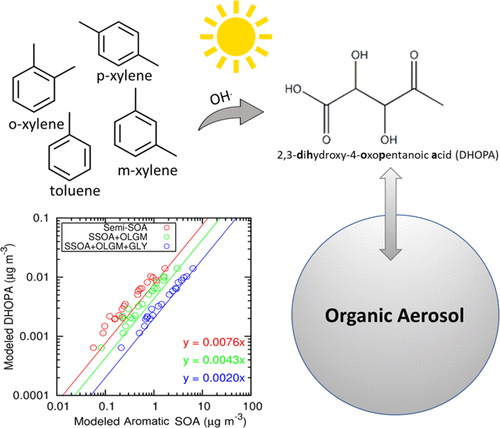当前位置:
X-MOL 学术
›
Environ. Sci. Technol.
›
论文详情
Our official English website, www.x-mol.net, welcomes your
feedback! (Note: you will need to create a separate account there.)
Estimation of Aromatic Secondary Organic Aerosol Using a Molecular Tracer—A Chemical Transport Model Assessment
Environmental Science & Technology ( IF 10.8 ) Pub Date : 2021-09-15 , DOI: 10.1021/acs.est.1c03670 Jie Zhang 1 , Xiao He 2 , Yaqin Gao 3 , Shuhui Zhu 2, 3 , Shengao Jing 3 , Hongli Wang 3 , Jian Zhen Yu 2, 4 , Qi Ying 1
Environmental Science & Technology ( IF 10.8 ) Pub Date : 2021-09-15 , DOI: 10.1021/acs.est.1c03670 Jie Zhang 1 , Xiao He 2 , Yaqin Gao 3 , Shuhui Zhu 2, 3 , Shengao Jing 3 , Hongli Wang 3 , Jian Zhen Yu 2, 4 , Qi Ying 1
Affiliation

|
A modified community multiscale air quality model, which can simulate the regional distributions of 2,3-dihydroxy-4-oxopentanoic acid (DHOPA), a marker species for monoaromatic secondary organic aerosol (SOA), was applied to assess the applicability of using the DHOPA to aromatic SOA mass ratio (fSOA) from smog chamber experiments to estimate aromatic SOA during a three-week wintertime air quality campaign in urban Shanghai. The modeled daily DHOPA concentrations based on the chamber-derived mass yields agree well with the organic marker field measurements (R = 0.79; MFB = 0.152; and MFE = 0.440). Two-thirds of the DHOPA are from the oxidation of ARO1 (lumped less-reactive aromatic species; mostly toluene), with the rest from ARO2 (lumped more-reactive aromatic species; mostly xylenes). Modeled DHOPA is mainly in the particle phase under ambient organic aerosol (OA) loading but could exhibit significant gas-particle partitioning when a higher estimation of the DHOPA vapor pressure is used. The modeled fSOA shows a strong dependence on the OA loading when only semivolatile aromatic SOA components are included in the fSOA calculations. However, this OA dependence becomes weaker when non-volatile oligomers and dicarbonyl SOA products are considered. A constant fSOA value of ∼0.002 is determined when all aromatic SOA components are included, which is a factor of 2 smaller than the commonly applied chamber-based fSOA value of 0.004 for toluene. This model-derived fSOA value does not show much spatial variation and is not sensitive to alternative estimates of DHOPA vapor pressures and SOA yields, and thus provides an appropriate scaling factor to assess aromatic SOA from DHOPA measurements. This result helps refine the quantification of SOA attributable to monoaromatic hydrocarbons in urban environments and thereby facilitates the evaluation of control measures targeting these specific precursors.
中文翻译:

使用分子示踪剂估计芳香二次有机气溶胶 - 化学传输模型评估
改进的社区多尺度空气质量模型可以模拟 2,3-二羟基-4-氧代戊酸 (DHOPA) 的区域分布,这是一种单芳族二次有机气溶胶 (SOA) 的标记物种,用于评估使用DHOPA 与芳香族 SOA 质量比 ( f SOA ) 来自烟雾室实验,用于估算上海城市为期三周的冬季空气质量活动期间的芳香族 SOA。基于室导出的质量产量建模的每日 DHOPA 浓度与有机标记场测量结果非常吻合 ( R= 0.79; MFB = 0.152;和 MFE = 0.440)。三分之二的 DHOPA 来自 ARO1(集中的反应性较低的芳香族物质;主要是甲苯)的氧化,其余来自 ARO2(集中的反应性较强的芳香族物质;主要是二甲苯)。模拟的 DHOPA 在环境有机气溶胶 (OA) 负载下主要处于粒子相,但当使用更高的 DHOPA 蒸气压估计值时,可能会表现出显着的气体-粒子分配。当f SOA计算中仅包含半挥发性芳香族 SOA 组分时,建模的f SOA显示出对 OA 负载的强烈依赖性。然而,当考虑非挥发性低聚物和二羰基 SOA 产品时,这种 OA 依赖性变得更弱。常数f SOA当包括所有芳族 SOA 组分时,确定 ~0.002 的值,这比通常应用的基于室的f SOA值 0.004小 2 倍,用于甲苯。该模型得出的f SOA值没有显示太多空间变化,并且对 DHOPA 蒸气压和 SOA 产量的替代估计不敏感,因此提供了适当的比例因子来评估来自 DHOPA 测量的芳族 SOA。这一结果有助于改进城市环境中由单芳烃引起的 SOA 的量化,从而促进针对这些特定前体的控制措施的评估。
更新日期:2021-10-06
中文翻译:

使用分子示踪剂估计芳香二次有机气溶胶 - 化学传输模型评估
改进的社区多尺度空气质量模型可以模拟 2,3-二羟基-4-氧代戊酸 (DHOPA) 的区域分布,这是一种单芳族二次有机气溶胶 (SOA) 的标记物种,用于评估使用DHOPA 与芳香族 SOA 质量比 ( f SOA ) 来自烟雾室实验,用于估算上海城市为期三周的冬季空气质量活动期间的芳香族 SOA。基于室导出的质量产量建模的每日 DHOPA 浓度与有机标记场测量结果非常吻合 ( R= 0.79; MFB = 0.152;和 MFE = 0.440)。三分之二的 DHOPA 来自 ARO1(集中的反应性较低的芳香族物质;主要是甲苯)的氧化,其余来自 ARO2(集中的反应性较强的芳香族物质;主要是二甲苯)。模拟的 DHOPA 在环境有机气溶胶 (OA) 负载下主要处于粒子相,但当使用更高的 DHOPA 蒸气压估计值时,可能会表现出显着的气体-粒子分配。当f SOA计算中仅包含半挥发性芳香族 SOA 组分时,建模的f SOA显示出对 OA 负载的强烈依赖性。然而,当考虑非挥发性低聚物和二羰基 SOA 产品时,这种 OA 依赖性变得更弱。常数f SOA当包括所有芳族 SOA 组分时,确定 ~0.002 的值,这比通常应用的基于室的f SOA值 0.004小 2 倍,用于甲苯。该模型得出的f SOA值没有显示太多空间变化,并且对 DHOPA 蒸气压和 SOA 产量的替代估计不敏感,因此提供了适当的比例因子来评估来自 DHOPA 测量的芳族 SOA。这一结果有助于改进城市环境中由单芳烃引起的 SOA 的量化,从而促进针对这些特定前体的控制措施的评估。











































 京公网安备 11010802027423号
京公网安备 11010802027423号